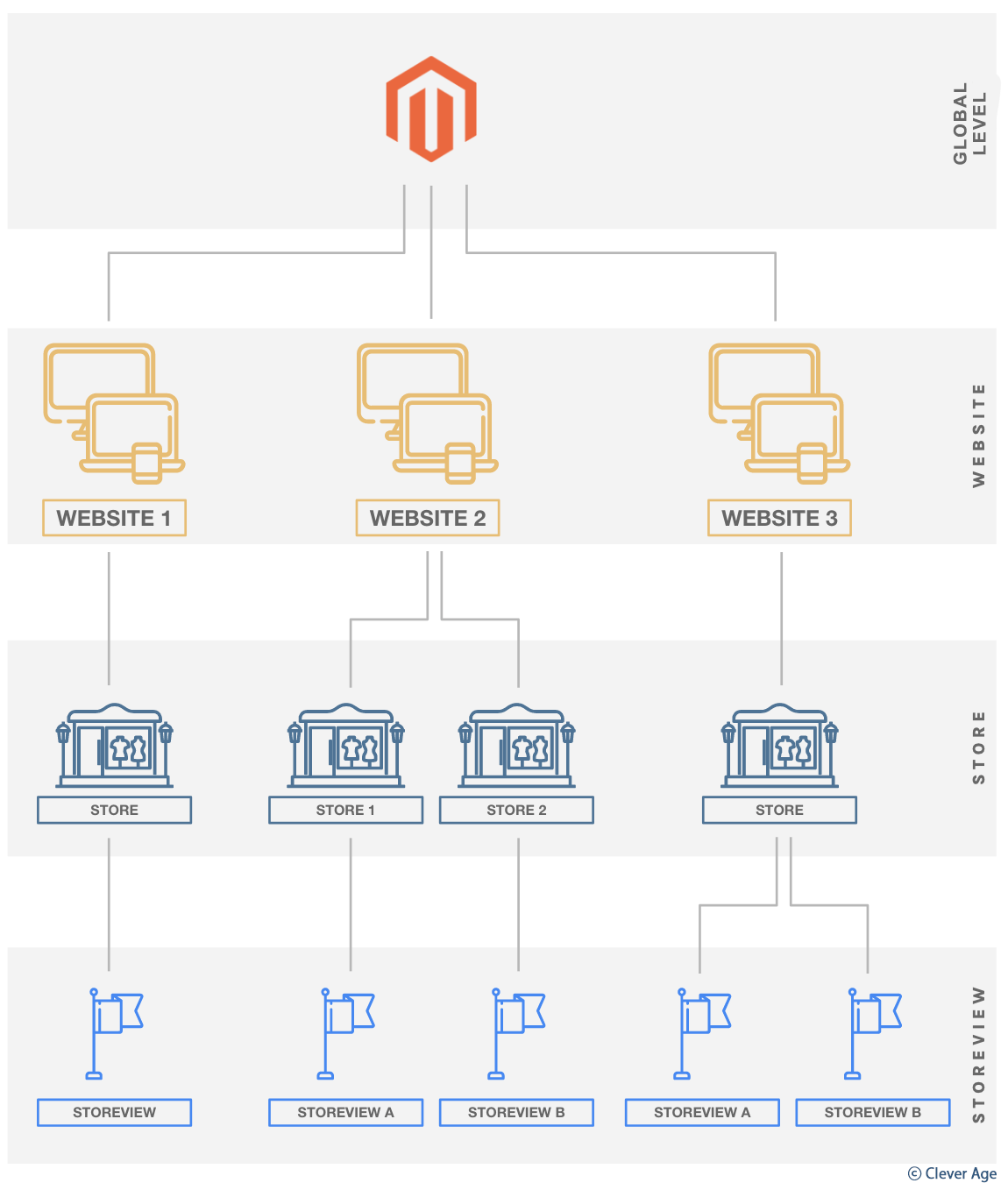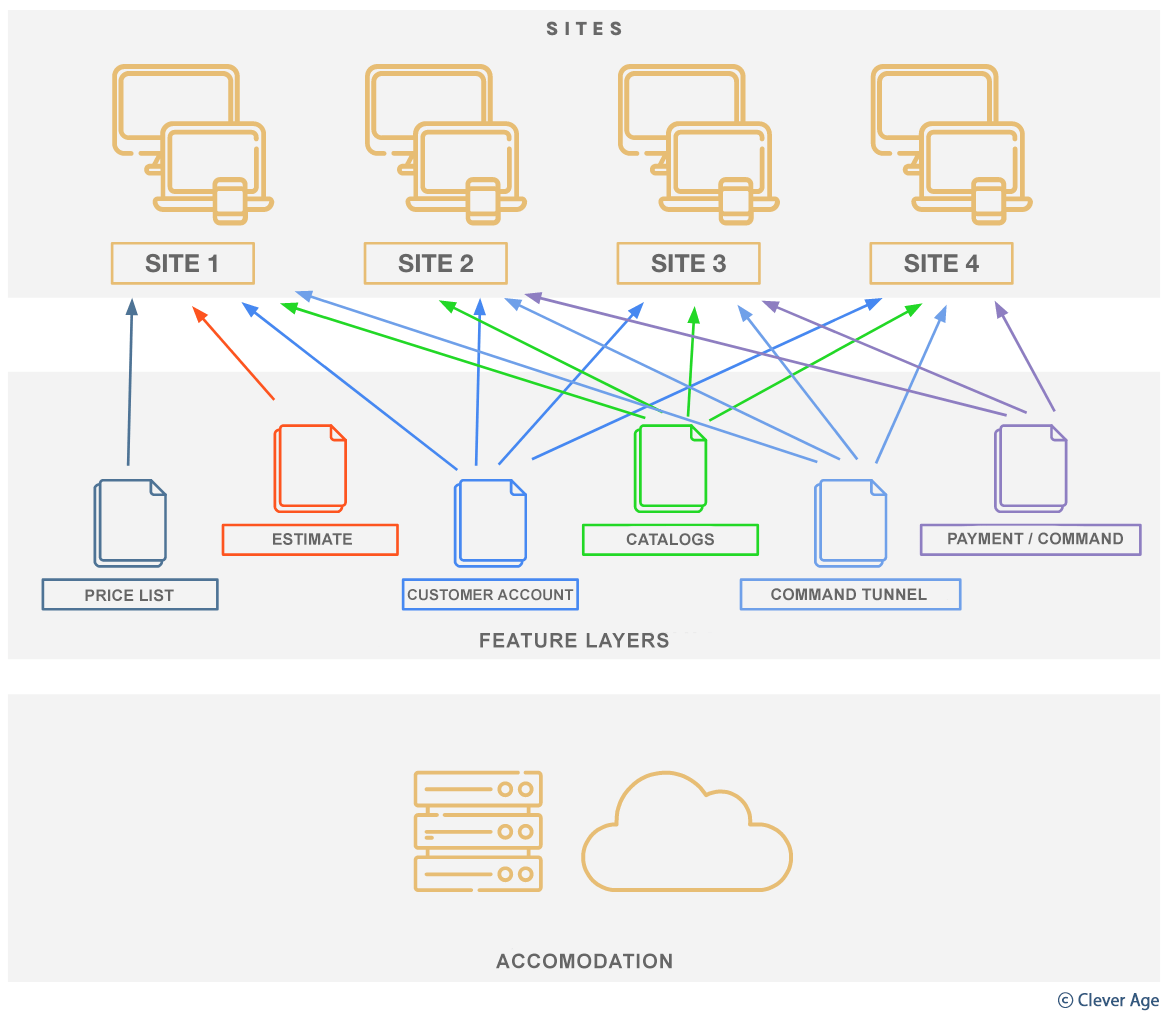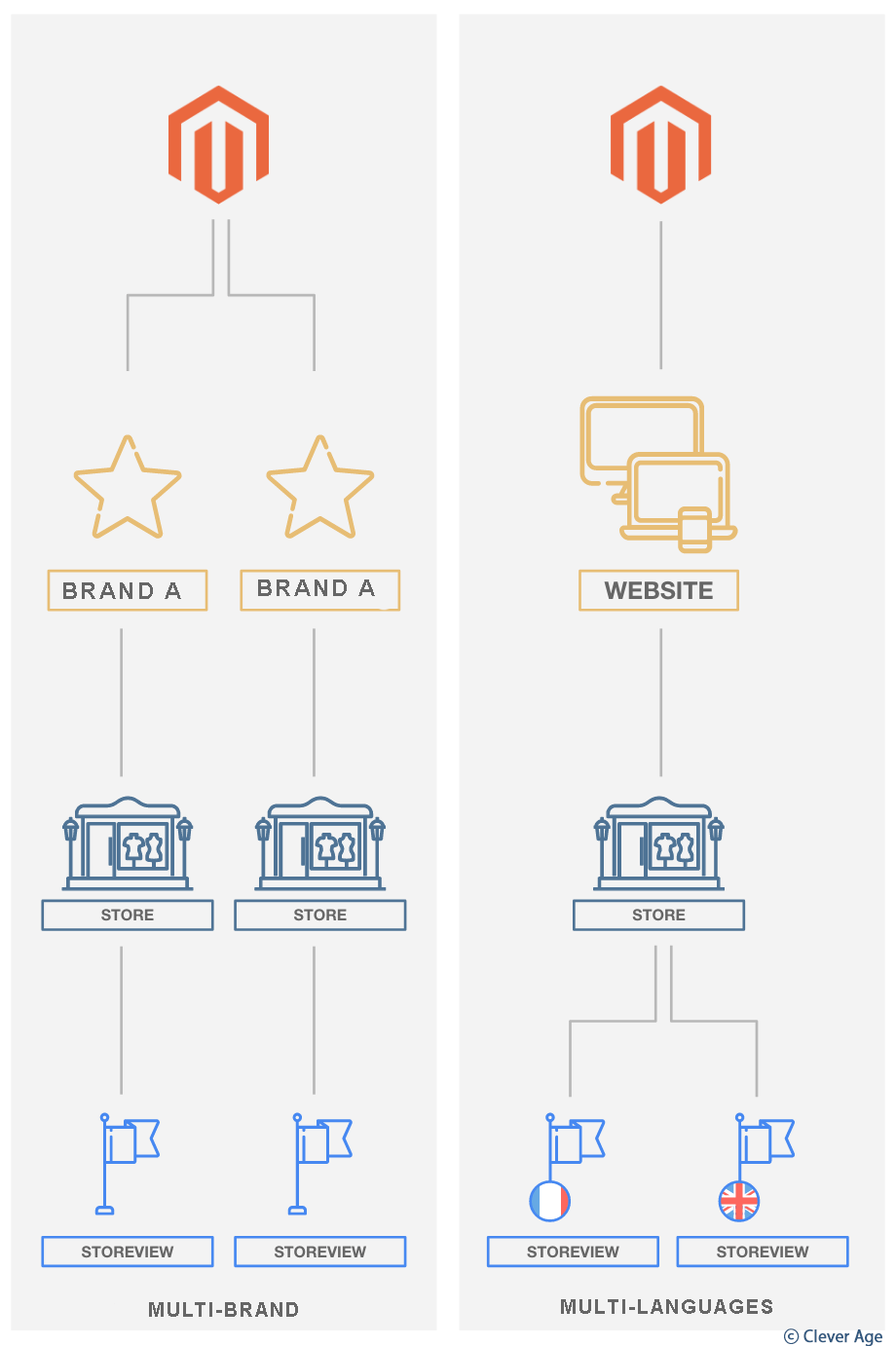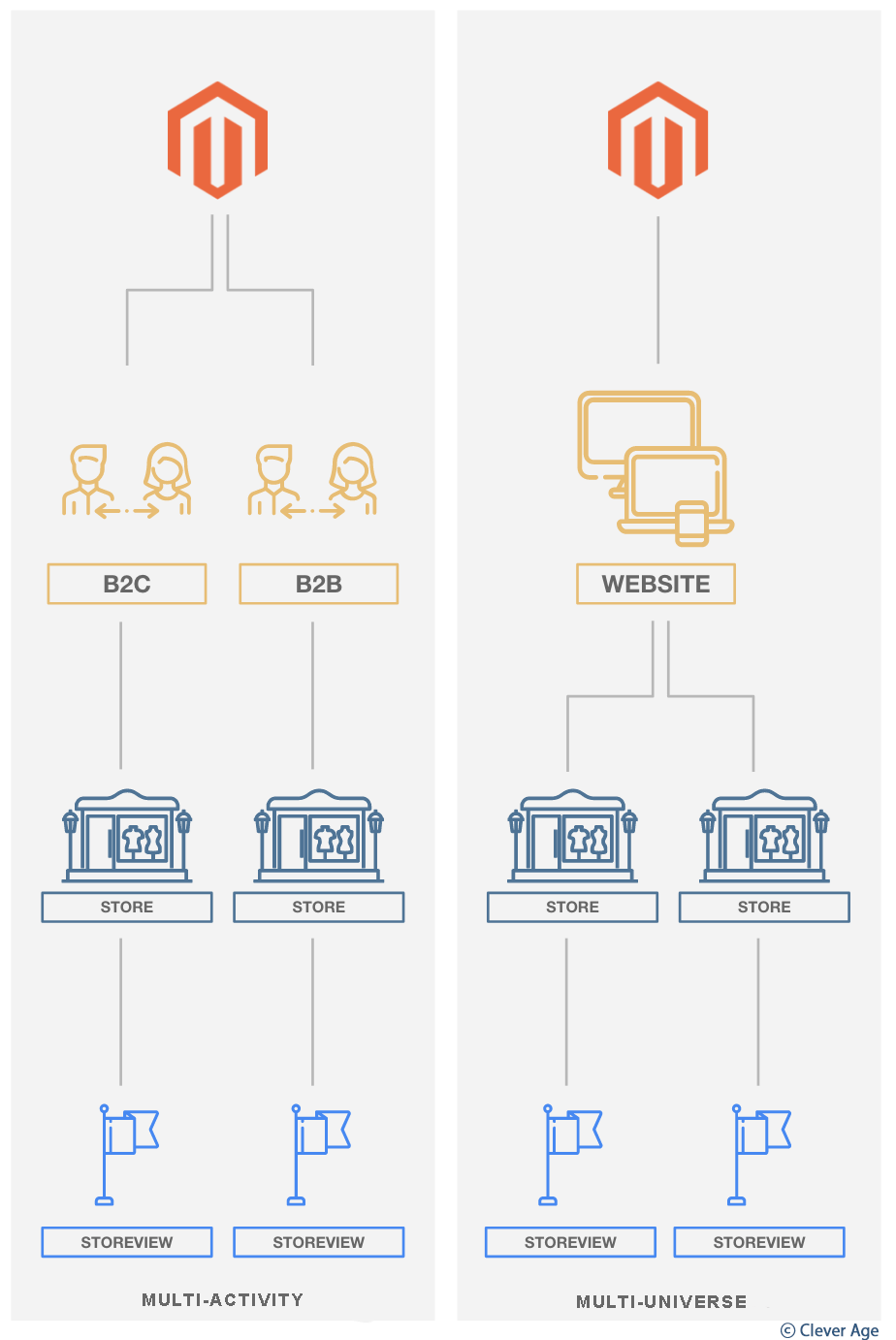INTRODUCTION
DEFINITION
First of all, how could we define the concept of multisite e-commerce ?
An e-commerce multisite can be defined as a network of several sites created from a single installation of an e-commerce solution.
Depending on the implemented architecture and the chosen e-commerce solution , the sites will be able to share functionalities, graphic themes, plugins, and a database. The multisite also brings a certain flexibility by allowing the activation/deactivation of functionalities according to the target site.
Similarly, a single hosting system can host several sites from a single instance.
WHAT CONTRIBUTIONS ?
1/ An undeniable time saving for customer contexts rich in various e-commerce offers :
- Centralized administration via a single backoffice for day-to-day management by marketing and IT teams,
- Centralization of content that can be shared with all sites. A block of editorial content can be written and published for all sites at once,
- Centralized management of user accounts that must access the site backoffice and profile management with rights to manage access restrictions by site or not,
- Changes that can be deployed once for all sites and then be activated or deactivated on the target sites.
2/ An economic gain on technical and infrastructure aspects :
- Centralization of sites on a single hosting,
- Application maintenance controlled by the fact that developments and upgrades can be factored across all sites,
- A saving of time and money for the creation of a new site which consists in relying on the existing rather than creating “from scratch”.
MULTISITE, IN WHICH CASES ?
Several scenarios can induce multisite :
- Have a multi-brand offer in “silo” where each brand is a site within a Group,
- Expand internationally by having sites that potentially offer different offers (product catalog, payment features, delivery for example) and manage different languages,
- Address a strategy around “white label”,
- Address different offer models via the same e-commerce solution instance, such as having a B2C and B2B site on the same solution instance.
MAGENTO AND MULTISITE
One of the advantages of Magento is to offer multisite management from the very beginning of Magento 1 and whether with the free or paid version.
The design of the multisite implemented in Magento provides enough flexibility to be able to consider a number of combinations according to the need and this, on the same instance.
Everything lies in the existence of entities in the Magento sense with 4 main levels :

| ENTITY | CHARACTERISTICS | RELATIONSHIPS |
| Global | This is the highest level that represents the Magento instance | |
| Website | It is similar to the notion of site, with :
– own domain name – its own graphic charter – its own product catalog, – potentially its own customer accounts, – its own orders. – It can also have its own functionalities such as different payment or delivery methods compared to other sites of the same instance |
several websites can be attached to a single Magento instance |
| Store | It can be similar to the management of different universes in the same website. He can have :
– its own graphic charter – its own catalog – its own navigation |
Relationships |
| Storeview | This is the lowest level and whose main function is to manage multi-languages and multi-currencies | 1 store can have multiple storeviews |
NB :
This organization in different levels also takes on its importance on :
- all the features offered natively in Magento
- integrated modules to meet a need not addressed natively
- custom developments carried out as part of certain projects
Indeed, the setting of each feature is associated with a level in Magento and in fact determines its bearing in the application.
Thus on a new functionality, it is necessary to determine at which level each configuration parameter must be associated.
- Associated at the global level, the parameter will be accessible and applied in the same way for all websites
- Associated with the website level, the parameter can be accessed and applied differently by website
- Associated with the storeview level, the parameter will be accessed and applied differently by storeview.
Examples of configuration parameters :
- enable feature
- contact email address
- delivery rates
Some examples of design cases :
SOME EXAMPLES OF IMPLEMENTATION :
It is very common in e-commerce projects with Magento to implement a multisite architecture. Our customers are the best proof of this.
https://www.pharmacielafayette.com/ is a Magento 2 site for the online sale of drugs and parapharmacy products. In order to meet the regulations for the online sale of pharmaceutical products and the organization of affiliated pharmacies of the Lafayette Pharmacie network, each pharmacy is a Magento website.
Thus, each website (pharmacy) has its own catalog, its own availability and in this case its customer accounts. Similarly, the basket is mono-pharmacy.
https://www.eram.fr/ is a Magento 2 site where the multisite has been implemented to meet the needs of addressing online sales internationally, in several languages as well as multi-brands.
https://bic.com is a site created in Magento 2. In addition to multi-country and multi-language management, the multisite has been used to meet the needs of online sales to individuals (B2C) and to networks of professionals in the sector (B2B).
CLEVER AGE REVIEW ON MAGENTO MULTISITE
Multisite management remains very well thought out in Magento with great flexibility allowing us to address a number of structuring cases according to the needs and organization of our customers.
However, its use requires upstream work to make sure to choose the best structure to implement according to the need. It is therefore important to keep in mind certain biases of the publisher which will have a real impact on the choice of the multisite structure to be implemented.
Conceptual points of attention :
- Management of customer accounts : With multisite, the question arises of having cross-functional customer accounts for all sites or partitioned by site.
Both are feasible in Magento, however once the choice is made, it must be considered irremediable. There is no real easy way to switch from one model to another. - Currency management : The declaration of a currency is done at the website level in Magento. This design necessarily guides the choice of the multisite if the platform must address countries with different currencies. It will then be necessary to create, for example, two different websites if it is necessary to address European countries and the USA. It is however possible to have a multi-currency storeview, but in this case it is a question of being able to manage conversions and not of having different prices.
- Multi-language management : This is managed in particular at the lowest level of the entities, namely the storeview where the code entered may refer to the language code to appear in the url of the website. This mechanism encounters a difficulty as soon as we approach the case of a multi-country language such as English or French. The code of a store is unique in Magento, so we cannot have two storeviews with the code fr for two different websites (France / Belgium). It is therefore necessary from the start to think in terms of a country code-language code couple. In the case cited, we will thus have a storeview fr-fr (for French France) and a storeview be-fr (for French Belgium).
- Performance : Who says several websites in Magento potentially means several catalogs, even different product offers with all that this implies in terms of Cartesian product (number of websites x number of catalogs x number of products x number of attributes). It is therefore essential on multisite with Magento to engage in substantive work on maintaining performance :
- optimize indexes
- apply a powerful, scalable and robust cache policy
- set up website monitoring
- Consider, from a certain threshold in terms of number of websites, moving towards multi-site multi-instances.
- Industrialization : Without going to talk about factory sites, setting up multi-site must be an opportunity to put in place procedures :
- duplication of websites
Magento, through its many functional settings, provides enormous flexibility in website creation. On the other hand, it is quickly impossible to manage these website creations by going “manually” to make the settings. It quickly becomes essential to go through initialization scripts that Magento manages very well.
One regret, however, is that the publisher has never made ready-to-use “starter kits” available to save time. - deployment
Creating multisite quickly requires setting up procedures upstream and downstream for the deployment of any new site. Beyond the configuration, one of the often time-consuming points remains the integration of a language. Magento manages translations on 2 levels :- the labels of the templates/forms which are generally found in many CSV files
- the labels that correspond to settings and that are found in the database
- duplication of websites
This is a point to anticipate, because there is no export in Magento allowing you to retrieve the items to be translated for a new website.



